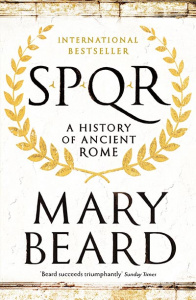SPQR: A History of Ancient Rome
 By Mary Beard
By Mary Beard
Review by Leonie (Classical Archaeology and Ancient History)
After having seen an episode of Mary Beard’s documentary series Meet the Romans at school – which I highly recommend as well, especially if you want to visualize the archaeological remains at Rome – I decided to read her book SPQR: A History of Ancient Rome. The author offers a general outline of the Roman history from the period of the Roman kings in the eighth century BC until the year 212 AD, when all the inhabitants of the Roman Empire were granted the Roman citizenship by the emperor Caracalla. Before reading this book, I found it very hard to know how different events in the history of Rome were related to each other, but thanks to SPQR I finally got the overview I was looking for!
My favourite thing about this book is that it succeeds in combining the material sources of archaeology with the written sources of history, which is the main aim of Classical Archaeology and Ancient History, the course I study at Oxford. In this respect, I particularly enjoyed the part about the Roman kings. The stories of Livy – a Roman historian who lived in the first century BC – about Romulus and Remus, and about the six other successive kings were often dismissed by nineteenth-century sceptics as mythical. However, excavations of the Forum Romanum brought to light a pillar from the sixth century BC with an inscription containing the word “king” in Latin. This indicates that there must have been some type of king, and that the nineteenth-century scholars were probably wrong! I included this discussion in my personal statement because it really shows how much history needs archaeology to give us the best possible image of Ancient Rome.
The SPQR in the title of the book stands for “Senatus PopulusQue Romanus”, which means the Senate and the People of Rome. As suggested by these Latin words, the book does not only focus on the big men of Ancient Rome and their feats (or more often misbehaviour), such as Caesar and his conquest of Gaul or the emperor Nero and his role in the Great Fire of Rome. It also considers the daily life of the ordinary Roman people. The narrative is, however, not restricted to men because Mary Beard pays a lot of attention to the role of women. This makes her approach quite unconventional, and thus refreshing. I would really recommend this book to anyone who has an interest in Ancient Rome, whether or not you have any prior knowledge. But, take care, Mary Beard’s enthusiasm for the subject is contagious!
Review by Freya (Classics)
Mary Beard is a bit of a legend among classicists. I had seen her on TV before and we had watched some clips of her in class, but I had never read any of her books. I read SPQR in the summer between Year 12 and 13 when a friend lent it to me. (At the time of writing this I have yet to give it back as I’m currently re-reading it!). Although it was a bit intimidating at first because it’s quite a thick book, what I really love about Mary Beard is that her writing is so accessible, not just in terms of content, but style as well. Before I came to uni, one of my biggest fears was that all of the books I had to read were going to be written in very formal, stuffy English that I just wouldn’t be able to understand, but here was a book written by a world-renowned academic that I could understand easily. It gave me a real confidence boost, knowing that I could understand academic concepts involving history and politics, and I think that was what I needed to fully commit to applying to Oxford. The book doesn’t shy away from any concepts that are difficult or controversial, it just explains them in a way that makes them accessible.
Another feature that I really love about SPQR is that it is written thematically rather than chronologically, so whilst it is a brief history of Rome, it isn’t just like a timeline. This allows you to draw connections between events that happened in the, likely mythological, beginnings of Rome and the end of the Roman Republic. That is a skill I’ve found very useful since starting to write essays at uni. It also means you can dip in and out of the book without trying to remember what year you were reading about last.
Most importantly, I think, is that the book introduced me to the real uncertainty surrounding a lot of classics, which is something I’d never really considered, I’d always just taken for granted that what I was taught about people like Caesar was concrete history, and it’s not. Being aware of concepts like this, as well as the plethora of evidence you have to consider when studying classics, including literary and archaeological sources, made the remainder of my A Level in Classical Civilisation, as well as my transition to uni, somewhat easier. The fact that I’m re-reading the book for background knowledge is a testament to that. I would highly recommend it.
SPQR: A History of Ancient Rome by Mary Beard
ISBN-10: 9781846683817
ISBN-13: 978-1846683817
Try checking the availability of this book at your school or local library or explore second hand bookshops and websites. You may also wish to purchase from either Amazon or Blackwell’s.
